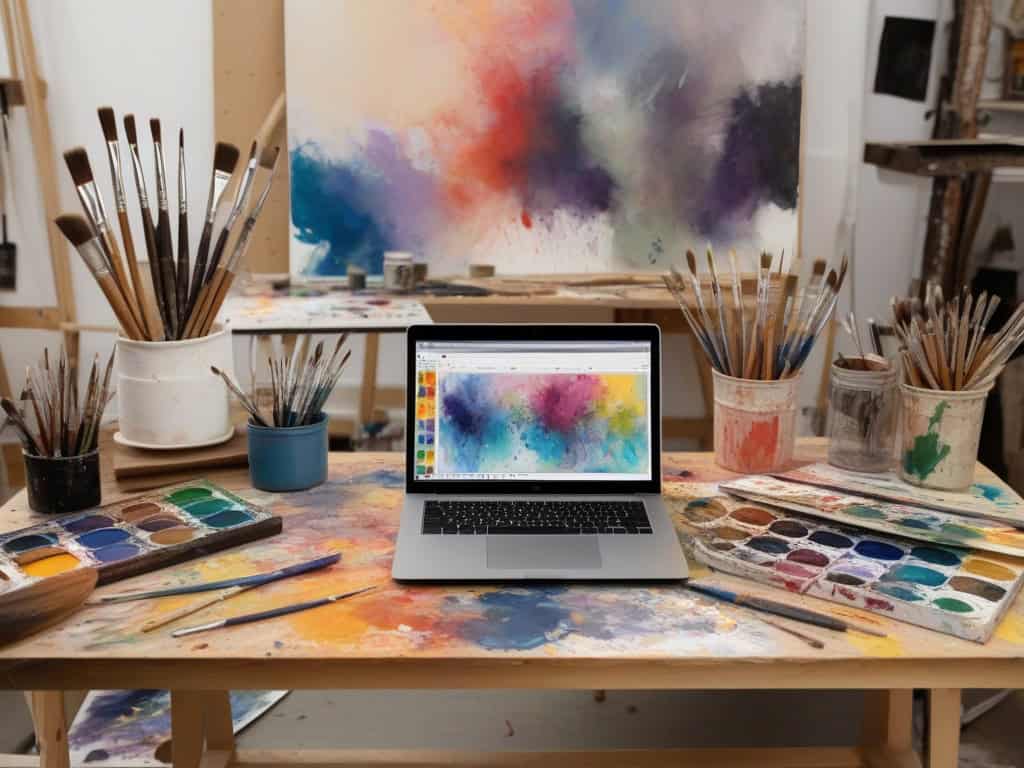
As a landscape artist with years of blogging experience, I’ve learned that starting an art blog can be an exhilarating journey into online creativity and potential income. I’ve spent years sharing painting tutorials and tips on capturing the beauty of landscapes, which has helped me connect with fellow artists and boosted my visibility on Google.
In this comprehensive guide, I’ll walk you through the essentials of creating an art blog, from the initial brushstrokes of planning to the finishing touches of monetization.
Blogging Basics
Before we dive into the colorful world of art blogging, it’s crucial to understand the fundamental elements. Just as every masterpiece begins with a sketch, your blogging journey starts with some key decisions:
- Selecting your artistic niche
- Choosing the right blogging platform
- Creating high-quality, visually rich content
Selecting Your Artistic Niche
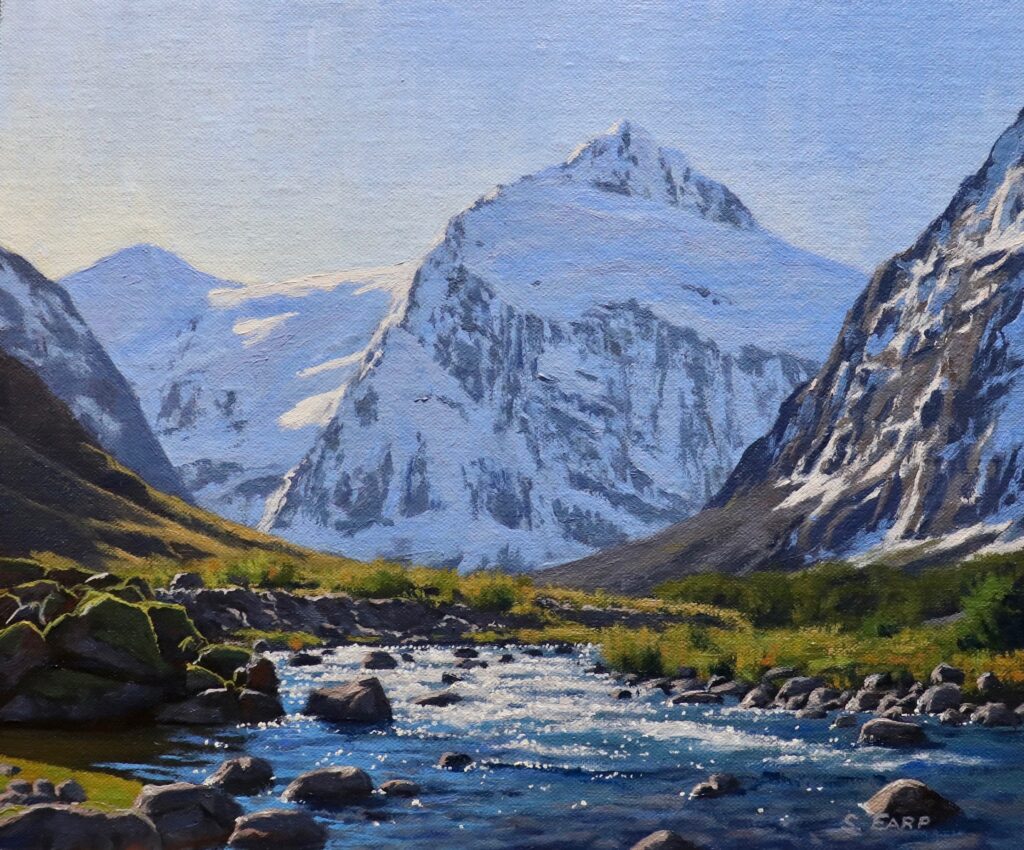
While my focus has been on landscape painting, your art blog could specialize in various areas like digital art, sculpture, mixed media, or even art history. Finding your niche helps you stand out in the vast gallery of the internet.
Choosing the Right Blogging Platform
Think of your blogging platform as the frame for your artistic expression. In my experience, a self-hosted WordPress site offers the flexibility and control most artists need. It’s like having a blank canvas with endless possibilities.
Creating Quality Content
Your blog posts are your artwork in written form. Whether you’re sharing tutorials, reviewing art supplies, or discussing techniques, your content should be as captivating as your visual art.
Setting Up Your Digital Studio
One of the first technical steps in your blogging journey is choosing a hosting plan. It’s like selecting the perfect studio space for your art. Many hosting companies offer affordable options, but it’s crucial to find one that balances cost with reliable customer service and performance.
Once you’ve set up hosting and installed WordPress, you can choose a theme that complements your artistic style. With these elements in place, you’re ready to start publishing content and embark on your journey towards building an audience and potentially generating income from your art blog.
Monetizing Your Artistic Voice
While the joy of sharing your art is rewarding in itself, there are various ways to monetize your blog:
- Google AdSense: Earn money when visitors click on ads displayed on your blog.
- Affiliate links: Recommend art supplies or courses and earn a commission when your readers make purchases.
- Selling your own art or digital products
Success in art blogging isn’t just about making money; it’s about building your personal brand as an artist, establishing credibility in your niche, and creating content that resonates with your audience.
In the following sections, we’ll delve deeper into each aspect of starting and growing your art blog. Whether you’re a seasoned artist looking to expand your online presence or a beginner eager to share your creative journey, this guide will help you paint your path to blogging success.
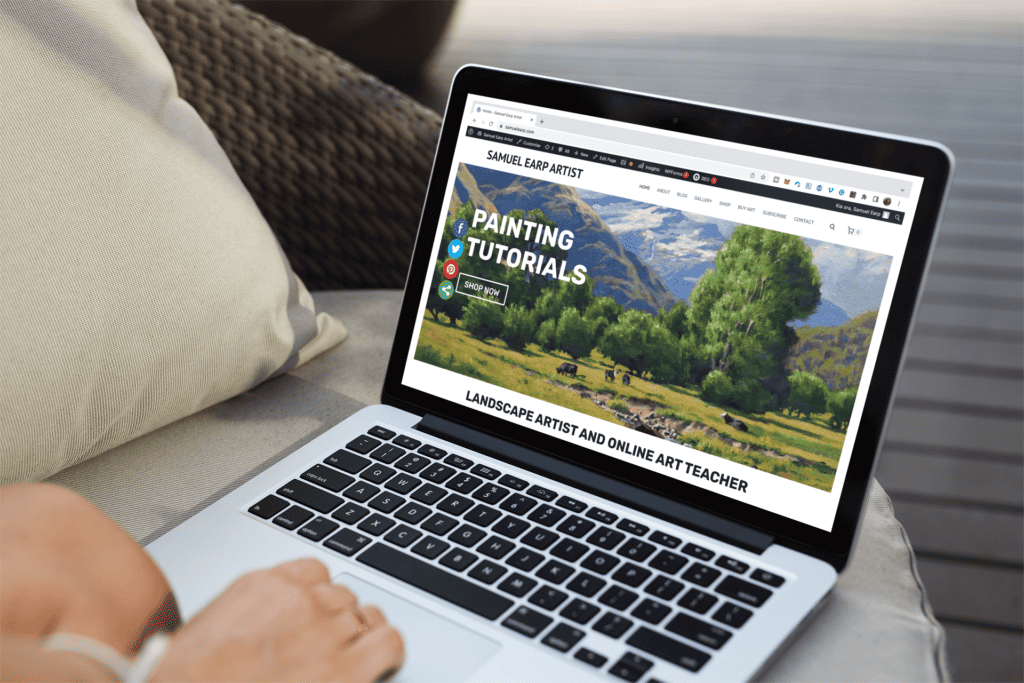
Understanding the Art Blogging World
As an artist blogging for years, I’ve seen firsthand how the digital landscape has transformed how we share and experience art. The art blogging world is a vibrant, ever-changing canvas that spans from personal sketchbook journals to professional art technique tutorials. It’s a space where artists like us can showcase our work, share our creative processes, and connect with art enthusiasts from every corner of the globe.
The Evolving Palette of Art Blogging
When I first started my painting blog, I focused solely on sharing my painting techniques. But many years later, I learned that the art blogging world is so much more diverse and dynamic. Today, successful art blogs encompass:
- Step-by-step tutorials
- Art supply reviews
- Artist interviews
- Art history discussions
- Behind-the-scenes studio tours
- Time-lapse videos of artwork creation
The key is to find your unique voice and perspective that sets you apart in this colorful digital gallery.
Embracing New Technologies
In recent years, I’ve noticed significant changes in the art blogging sphere, particularly with the advent of AI. As artists, we need to be aware of these developments:
- AI-generated art: While controversial, it’s opening up new discussions about creativity and authorship.
- AI writing tools: These can help with blog post ideas or overcoming writer’s block, but remember – your unique artist’s voice is irreplaceable.
- Virtual and augmented reality: These technologies are creating new ways to display and interact with art online.
Building Your Art Community
One of the most rewarding aspects of art blogging is becoming part of a global creative community. Through my blog, I’ve connected with fellow landscape artists, art supply manufacturers, and art collectors. This network has not only inspired but has also opened up opportunities for collaborations and sales.
The Brushstrokes of Success
To thrive in the art blogging world, I’ve learned that several elements are crucial:
- Engaging visual content: As artists, we have an advantage here. High-quality images of your work are essential.
- SEO for artists: Learn to use keywords related to your art style, medium, and subjects to help art lovers find your blog.
- Consistent posting: Whether it’s weekly updates on your current project or monthly in-depth tutorials, consistency keeps your audience engaged.
- Monetization strategies: From selling original art and prints to offering online courses or using affiliate links for art supplies, there are various ways to earn from your blog.
Finding Your Niche
While my niche is landscape painting, the art world is vast. Whether you’re into digital illustration, sculpture, mixed media, or any other form of visual expression, there’s an audience eager to follow your creative journey.
As an art blogger, you’re not just sharing your work; you’re contributing to the rich, global tapestry of online artistic expression. Your unique perspective and skills are your most valuable assets in this digital age.
Planning and Setting Up Your Art Blog
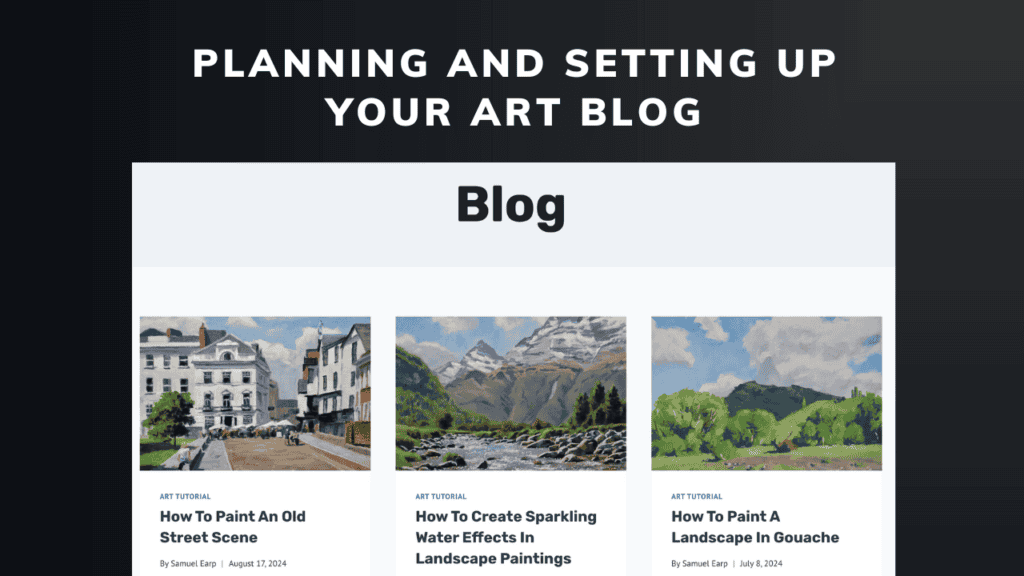
As an artist who’s been blogging for years, I can’t stress enough how crucial the initial planning and setup phase is. It’s like preparing your canvas and choosing your palette before starting a masterpiece. In my journey of sharing landscape paintings online, I’ve learned that these early decisions can significantly impact your blog’s long-term success.
Discovering Your Artistic Niche
Finding your niche in the art blogging world is like developing your unique style as an artist. It’s what sets you apart and helps you connect with your ideal audience. When I started, I focused on landscape painting tutorials, which not only aligned with my passion but also filled a gap I saw in the online art community.
Why Choosing a Niche is Crucial for Art Bloggers
Choosing a specific niche helps you:
- Create focused content that resonates with fellow artists and art enthusiasts
- Establish yourself as an expert in a particular area of art
- Improve your chances of ranking on Google for specific art-related keywords
- Attract potential buyers or students if you’re selling art or teaching
Strategies for Finding Your Art Blog Niche
To find your niche, consider:
- Your artistic strengths and passions
- Gaps in the online art education market
- Trending topics in the art world
- Intersections between your skills and market demand
For instance, my landscape painting niche combines my expertise, passion, and a clear demand from aspiring painters looking to improve their skills.
Naming Your Blog
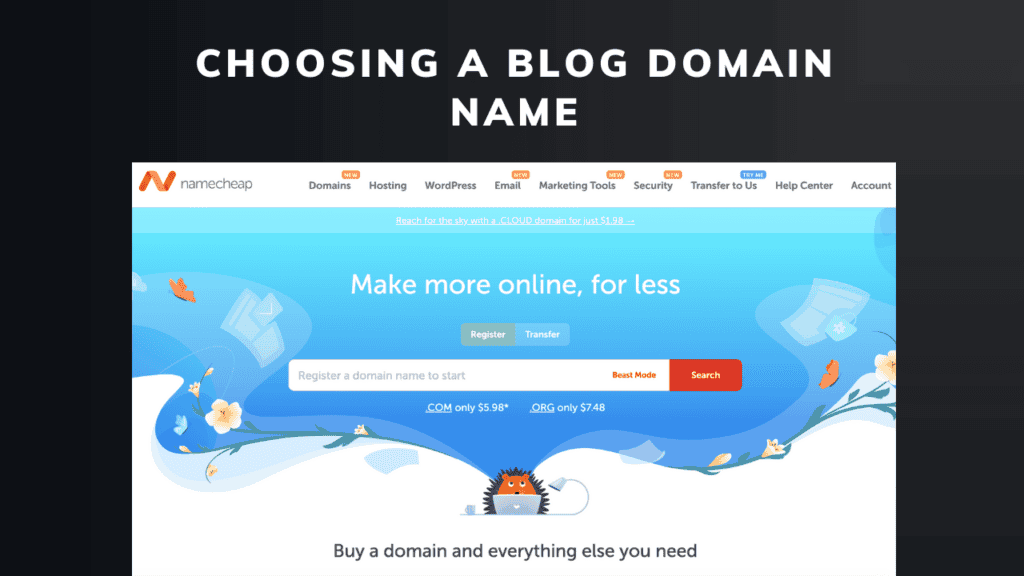
Choosing a name for your art blog is like selecting the perfect frame for a masterpiece. It needs to complement your work, capture your essence as an artist, and intrigue your audience. But there’s more to it than just sounding good; your blog’s name is a crucial part of your brand strategy.
Building the Brand of You
After years of blogging, I’ve come to realize that the best domain name you can use is often the simplest: your own name. My blog, samuelearp.com, is a testament to this approach. Here’s why I believe using your name is a smart choice:
- Flexibility: It allows you to pivot and evolve your content without being tied to a specific niche.
- Personal branding: You’re building a brand around yourself as an artist, not just your current focus.
- Long-term vision: Your name won’t become outdated or limiting as your art and interests develop.
Using your name as your domain gives you the freedom to explore various aspects of art, share different techniques, or even branch out into related fields without feeling constrained by your blog’s name.
Alternatives to Using Your Name
If you prefer not to use your own name, that’s okay too. Just remember these key points when brainstorming blog names:
- Avoid Narrow Niches: Steer clear of names that pigeonhole you into a very specific area. For example, “paintingboatsblog.com” limits you to one subject matter and could become restrictive.
- Think Long-Term: Ask yourself, “Can I write about this topic for the next five years?” Your blog name should allow for growth and sustained interest.
- Keep It Broad: Choose a name that allows you to cover a wide range of art-related topics. This gives you the flexibility to expand your content as your blog grows.
- Make It Memorable: Your blog name should be:
- Easy to spell and remember
- Reflective of you, your artistic style or broader niche
- Incorporating art-related terms or your primary medium (if applicable)
Securing Your Digital Canvas: Domain Name Selection
Once you’ve settled on a name, it’s time to secure your digital real estate. Here’s where I highly recommend NameCheap. I’ve been using their services for years for domain registration and they’ve been fantastic.
My website is hosted on a server run by my brother, who manages all of the backend stuff on my website. However if I wasn’t using this, I would host my website using NameCheap.
A crucial tip: Always opt for a .com domain if it’s available. It’s the most recognized and trusted domain extension, making it easier for your audience to remember and find you online.
The NameCheap Advantage

Why do I recommend NameCheap? Here are a few reasons:
- Competitive pricing for domain registration
- User-friendly interface for managing your domain
- Excellent customer support (which is crucial when you’re focusing on your art, not technical issues)
- Seamless integration with their hosting services, which is perfect for WordPress sites
Your blog name and domain are often the first impression you make on potential readers or art buyers. It’s worth taking the time to get it right. Think of it as signing your digital artwork, make it authentic, make it memorable, and make it uniquely you.
Choosing Your Blogging Canvas: Platforms and Hosting
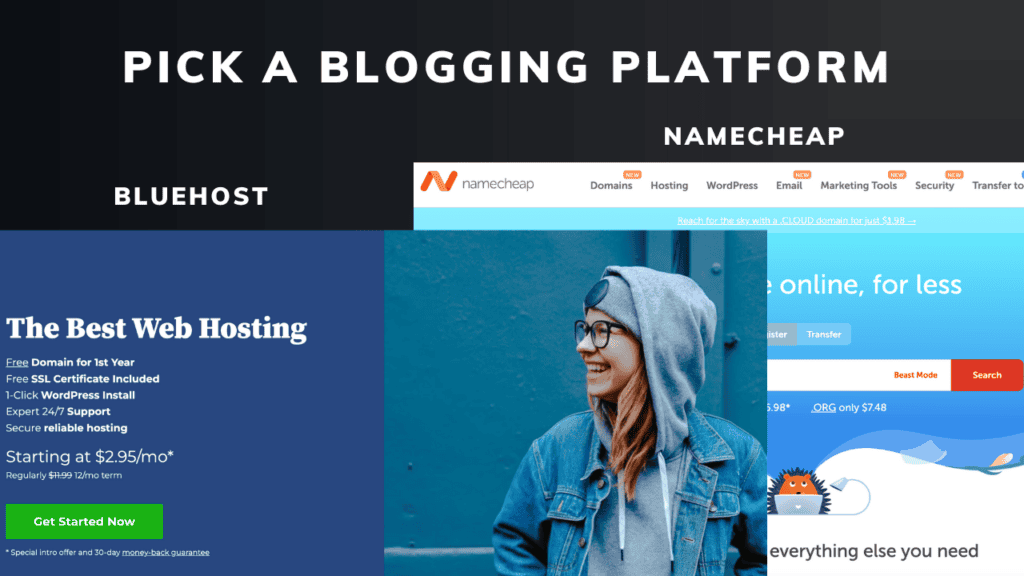
After years of experimenting, I can confidently say that WordPress is the best platform for bloggers, including art bloggers. It offers unparalleled flexibility, allowing you to showcase your artwork beautifully while providing powerful blogging tools.
Why I Recommend WordPress for Art Blogs
- Extensive customization options to match your artistic style
- Plenty of themes designed specifically for artists and creatives
- Robust plugin ecosystem for galleries, portfolios, and e-commerce
- Excellent SEO capabilities to help your art get discovered
Hosting Your Art Blog
For hosting, I personally use and recommend NameCheap. Their hosting plans are affordable, reliable, and come with excellent customer support – crucial when you’re focused on creating art rather than solving technical issues. However, if you’re looking for an alternative, BlueHost is also a solid option that I’ve heard good things about from fellow artists.

Setting Up Your Blog’s Foundation
Setting up your art blog is like preparing a studio space – it needs to be functional, inspiring, and ready for creation.
Domain Registration and Hosting Solutions
Here’s my step-by-step process:
- Go to NameCheap
- Search for your desired domain name
- Once found, add it to your cart
- Choose a hosting plan; I recommend their WordPress hosting for seamless integration
- Complete the purchase
Installing WordPress and Initial Setup
After securing your domain and hosting:
- Use NameCheap’s one-click WordPress installation
- Choose a theme that complements your artwork – there are many free options, but investing in a premium theme can really make your art shine
- Set up essential plugins for galleries, SEO, and security
- Create your main pages (Home, About, Gallery, Blog, Contact)
Remember, your blog’s design should enhance, not overshadow, your artwork. Keep it clean and let your art be the star of the show.
In the next section, we’ll dive into creating content that showcases your art and engages your audience. But for now, take your time with this setup phase. It’s the foundation upon which you’ll build your online artistic presence.
Building Your Artistic Haven: Crafting Your Blog
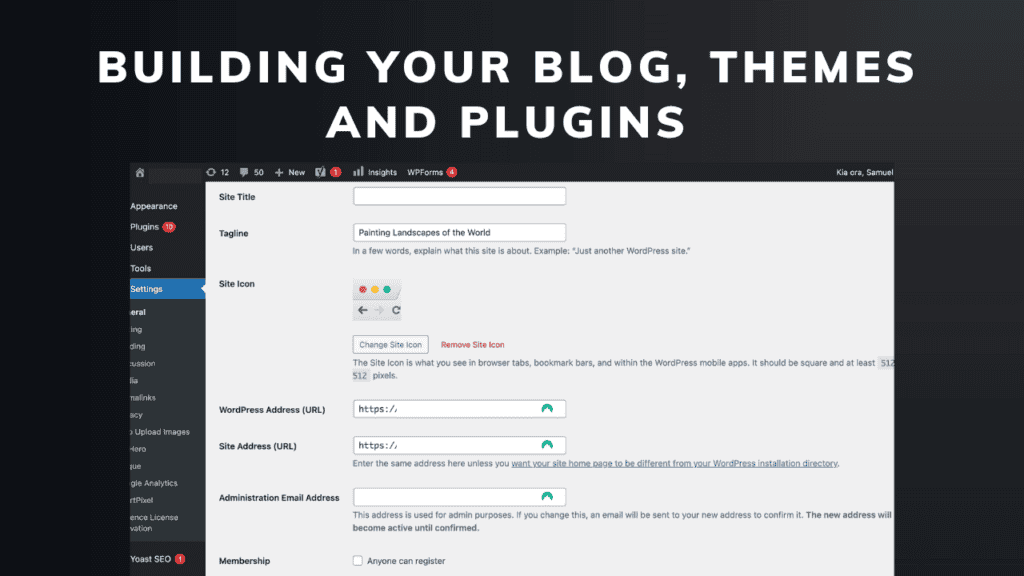
As an artist, I’ve learned that building a blog is much like creating a piece of art. It’s about crafting a digital space that not only showcases your work but also reflects your artistic vision and personality.
When I started my landscape painting blog, I quickly realized that it’s more than just uploading images of my work – it’s about creating an immersive experience for art enthusiasts and fellow artists alike.
Designing Your Art Blog for Success
Designing your art blog is like composing a visual masterpiece. It’s your online gallery, your artist’s statement, and your connection to the art world all rolled into one. When I redesigned my blog, I focused on creating an environment that would make my paintings shine while also telling my story and helping artists with their painting techniques.
Selecting a Theme: Why I Chose Kadence
Choosing the right WordPress theme for an art blog is crucial. It’s like selecting the perfect frame for your artwork. After extensive research and experimentation, I discovered the Kadence theme, and I can’t recommend it enough for fellow artists.
Kadence offers a clean, customizable design that puts the focus on your artwork. Its extensive options allow you to tailor every aspect to complement your artistic style. As artists, we need robust gallery features, and Kadence integrates beautifully with gallery plugins, allowing me to showcase my landscape paintings in various layouts.
One of the standout features of Kadence is its speed and performance. Your artwork deserves to load quickly, and Kadence is optimized to ensure your visitors don’t have to wait to see your creations. In today’s mobile world, it’s also crucial that your art looks great on all devices. Kadence ensures my paintings are displayed beautifully whether viewed on a phone, tablet, or desktop.
While we focus on creating art, it’s important that people can find our work. Kadence is built with SEO best practices in mind, helping your art blog rank better in search results. This has been invaluable in helping new audiences discover my landscape paintings.
Customizing Your Blog’s Design with Kadence
Once I installed Kadence, I dove into customization. Using the easy color customization options, I chose a color palette that complemented my landscape paintings. I adjusted the typography to reflect the mood of my art—clean and modern for titles, easily readable for blog post content.
Using Kadence’s header builder, I designed a header that included a rotating gallery of my best works. I fine-tuned the layout to ensure a smooth flow, guiding visitors through my galleries and blog posts.
Remember, every design decision should serve to showcase your art and engage your audience. With Kadence, I found it easy to create a cohesive visual experience that resonates with art lovers while maintaining a professional look.
Essential Plugins and Tools for Your Art Blog
As artists, we often focus on the visual aspects, but the technical side is equally important for a successful art blog. I’ve found certain plugins and tools indispensable for managing my blog effectively.
Must-Have WordPress Plugins for Artists
Here are some recommended plugins:
- Envira Gallery or NextGEN Gallery: These allow me to create beautiful, responsive galleries to showcase my artwork.
- Yoast SEO: Helps me optimize my posts so art enthusiasts can find my blog more easily.
- WP Smush: Compresses my high-resolution art images without losing quality, keeping my site fast.
- Akismet: Protects my blog from spam comments, keeping discussions about my art genuine.
- UpdraftPlus: Backs up my site regularly, ensuring I never lose my digital portfolio.
Tools for Artistic Productivity and Efficiency
Beyond plugins, there are several tools you can use to keep your art blog running smoothly:
- Trello: For planning my content calendar, tracking painting projects, and blog post ideas.
- Canva: To create graphics for social media posts about my art and blog.
- Google Analytics: To understand which of my artworks and posts resonate most with my audience.
- Adobe Lightroom: For editing and preparing my art images before uploading them to my blog.
By leveraging these plugins and tools, I’ve been able to create a blog that showcases my art beautifully and runs efficiently. This allows me to focus more on what I love—creating art—while still maintaining a strong online presence.
Remember, your art blog is an extension of your artistic practice. It should be as carefully crafted as your artwork itself. With the right design, plugins, and tools, you can create a digital space that truly represents you as an artist and engages your audience in meaningful ways.
Content Creation: The Heart of Your Art Blog
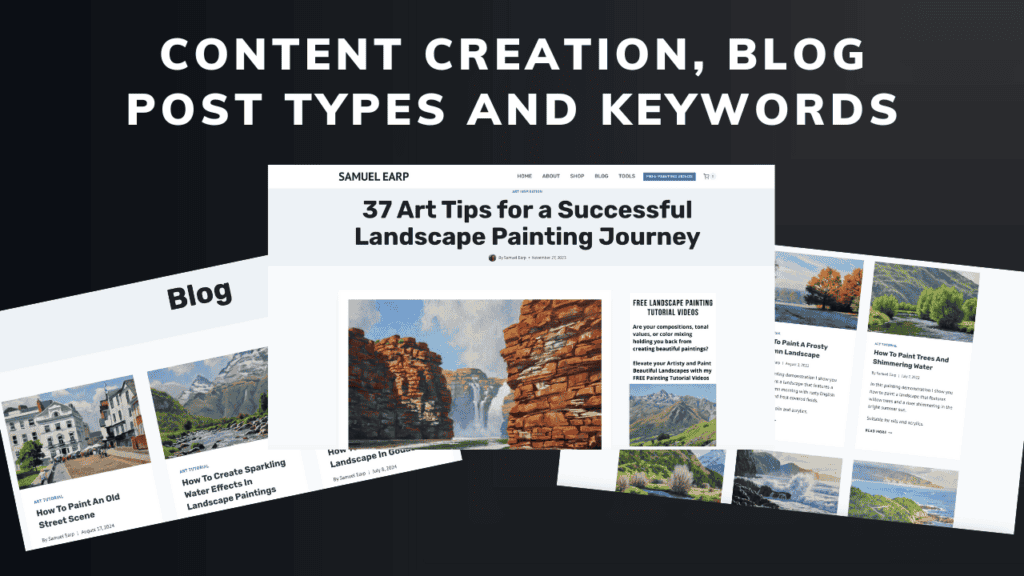
As a landscape artist, I’ve discovered that content creation is the lifeblood of my blog. It’s not just about showcasing my paintings; it’s about creating engaging, valuable content that resonates with fellow artists and art enthusiasts. Over the years, I’ve learned that a strategic approach to content is key to attracting readers and keeping them coming back for more.
Crafting Your Artistic Content Strategy
When I first started my art blog, I quickly realized that I needed more than just images of my paintings. I needed a content strategy that would connect with my audience on a deeper level. Here’s what I’ve learned:
- Understand Your Audience: Are they aspiring artists, collectors, or art appreciators? Knowing this helps me tailor my content.
- Diversify Your Content: I mix posts about my painting process, art tips, artist interviews, and art history to keep things interesting.
- Set Clear Goals: Whether it’s to inspire, educate, or sell artwork, having clear goals guides my content creation.
I regularly review my blog analytics to see which posts perform well. This feedback helps me refine my strategy and create more of what my audience loves.
The Role of Keywords in Art Blog Content
While my primary focus is creating authentic, valuable content for artists, I’ve learned that understanding keywords is crucial for getting my blog found. This is where KWHero has been a game-changer for me.
My Experience with KWHero
I use KWHero for both keyword research and content creation, and I can’t recommend it enough. Here’s why:
- Comprehensive Keyword Research: KWHero helps me find art-related terms that people are actually searching for. For example, I’ve discovered keywords like “landscape painting techniques” or “how to paint realistic trees” that I might not have thought of on my own.
- Content Creation Assistance: What sets KWHero apart is its ability to help me write articles. It provides content outlines and suggestions that ensure I’m covering all the important aspects of a topic while maintaining my unique artistic voice.
- SEO Optimization: KWHero guides me in optimizing my content for search engines without sacrificing readability or authenticity.
- Time-Saving: As an artist, my time is split between creating art and blogging. KWHero significantly reduces the time I spend on keyword research and content planning.
Types of Content for Art Blogs
In my experience, variety is key to keeping an art blog engaging. Here are some types of content that work well:
- Tutorial / Informational Posts: Step-by-step guides on painting techniques
- Transactional Blog Posts: Discussing the tools and materials I use. This is an opportunity to add affiliate links.
- Artist Spotlights: Featuring other artists I admire
- Behind-the-Scenes: Sharing my studio setup or work-in-progress
- Inspiration Posts: Sharing what inspires my art, from nature walks to other artworks
Writing Your First Art Blog Post
When I wrote my first blog post, I wrote a painting tutorial. Here’s my advice for new art bloggers:
- Introduce Yourself: Share your artistic journey and what inspires you.
- Show Your Work: Include high-quality images of your art.
- Provide Value: Offer a tip or insight that readers can apply to their own art.
- Be Authentic: Let your personality shine through your writing.
Your first post sets the tone for your blog. Make it a true reflection of you as an artist.
Tips for Engaging Art Blog Content
Over time, I’ve developed some strategies for creating content that resonates with my audience:
- Start with a Hook: I often begin posts with an intriguing question or a personal anecdote about my painting process.
- Use Visuals: As artists, we have an advantage here. I liberally use images of my work, sketches, and even video clips.
- Break It Down: I use subheadings and bullet points to make my posts easy to scan and read.
- Share Your Unique Perspective: Whether it’s my take on a classic technique or a new approach I’ve developed, I always aim to offer a fresh perspective.
- Encourage Interaction: I often end posts with questions, inviting readers to share their own experiences or artwork.
Maintaining Consistency in Your Art Blog
Consistency has been key to growing my blog. Here’s how I approach it:
How Often Should You Blog?
I aim for quality over quantity, and I try to aim for one blog post per week. However, this doesn’t always happen. If you can’t consistently write blog posts, then don’t lose sleep over it; just write as many as you can as consistently as you can.
Planning Your Art Blog Content Calendar
I use a content calendar to stay organized and ensure a good mix of topics. Here’s my approach:
- Plan Ahead: I map out posts for the next month, considering upcoming art events or seasons that might inspire content.
- Mix It Up: I alternate between different types of posts to keep things interesting.
- Be Flexible: While I plan ahead, I also leave room for spontaneous inspiration or trending art topics.
Your blog is an extension of your artistic practice. Let it evolve with you, and don’t be afraid to experiment with different types of content. The key is to create a space that inspires both you and your readers in your shared love for art.
By leveraging tools like KWHero for keyword research and content creation, you can streamline your blogging process and focus more on what you love – creating art and sharing your passion with the world.
Growing Your Art Blog
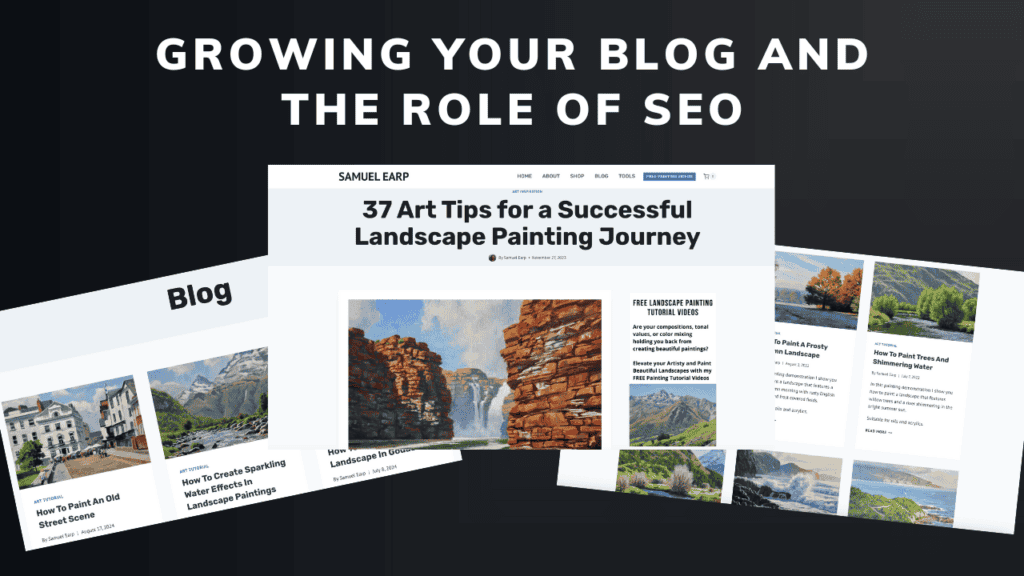
As an artist, I’ve learned that growing a blog involves much more than just showcasing my paintings. It’s about reaching new audiences, engaging with fellow art enthusiasts, and building a community around my creative journey. This growth phase has pushed me to wear many hats – from marketer to SEO specialist and even designer.
SEO Basics for Art Bloggers
Understanding SEO (Search Engine Optimization) has increased my blog’s visibility. Here are some key strategies I’ve implemented:
- Choose a Custom Domain: I use my name, samuelearp.com, which is relevant to my art brand and the brand of me.
- Use Relevant Keywords: I incorporate art-related keywords naturally in my posts, like “landscape painting techniques” or “plein air painting tips.”
- Optimize Images: I always use descriptive file names and alt text for my artwork images.
- Create Quality Content: I focus on writing in-depth, valuable posts that genuinely help other artists.
While SEO is important, your primary focus should always be on creating authentic, high-quality content that resonates with your audience.
Leveraging Social Media for Your Art Blog
Social media has been a game-changer in promoting my art blog. Here’s how I use different platforms:
- Instagram: I share work-in-progress shots and final pieces, using relevant hashtags like #landscapeartist or #oilpainting.
- Pinterest: I create pins for my blog posts, especially tutorials and art supply reviews.
- Facebook: I use my page to share longer posts and engage with my art community.
- YouTube: I’ve started a channel to share painting demos and tips, which drives traffic back to my blog.
The key is to tailor your content to each platform while maintaining a consistent brand voice across all channels.
Certainly! Here’s a short section on how Pinterest has been beneficial for promoting your blog posts, including your experience with Pin Generator and your affiliate relationship:
Pinterest: A Powerful Tool for Art Blog Promotion
As an artist and blogger, I’ve found Pinterest to be an invaluable platform for promoting my blog posts and reaching a wider audience. Pinterest’s visual nature aligns perfectly with my art-focused content, allowing me to showcase my paintings and tutorials in an engaging way.
To streamline my Pinterest strategy, I use Pin Generator, a tool that has revolutionized how I share my content. With Pin Generator, I can easily schedule my blog posts and create eye-catching pins that draw attention to my artwork and tutorials. This automation has saved me countless hours and ensured a consistent presence on the platform.
(Note: As an affiliate, I earn a commission if you sign up for Pin Generator through my link, but I genuinely use and recommend this tool for its effectiveness in promoting art blogs.)
By leveraging Pinterest and Pin Generator, I’ve seen a significant increase in traffic to my blog, connecting with art enthusiasts who might not have found my content through other channels. If you’re an artist looking to expand your blog’s reach, I highly recommend exploring the potential of Pinterest and considering tools like Pin Generator to enhance your promotion strategy.
Building an Email List: My Secret Weapon
Building an email list has been the most effective of all the strategies I’ve used to grow my art blog. It allows me to connect directly with my most engaged followers, share exclusive content, and promote my art and blog posts.
Why Your Art Blog Needs an Email List
An email list is crucial for several reasons:
- Direct Communication: Unlike social media, emails land directly in your subscribers’ inboxes.
- Deeper Engagement: You can share more personal insights and behind-the-scenes content.
- Promotion: It’s an excellent way to announce new blog posts, art releases, or workshops.
- Community Building: Regular emails help foster a sense of community among your followers.
My Experience with MailerLite
After trying various email marketing tools, I’ve found MailerLite to be the perfect fit for my art blog, and I highly recommend it. Here’s why:
- User-Friendly Interface: As an artist, I appreciate MailerLite’s intuitive design. It’s easy to create visually appealing emails that showcase my artwork.
- Affordable: Their pricing is very reasonable, especially for bloggers just starting out.
- Automation Features: I can set up automated welcome series and drip campaigns, saving me time while nurturing new subscribers.
- Segmentation Options: I can segment my list based on interests (e.g., oil painting enthusiasts vs. watercolor fans), allowing for more targeted content.
- Landing Page Builder: This feature has been great for creating dedicated pages for art series or special offers.
(Note: As an affiliate, I earn a commission if you sign up through my link, but I truly believe in MailerLite’s value for artists and bloggers.)

Tips for Growing Your Art Blog Subscriber Base
Here are some strategies that have helped me grow my email list:
- Offer a Valuable Incentive: I offer a free e-book: “Landscape Painting Blueprint” to new subscribers.
- Strategic Form Placement: I have subscription forms at the end of blog posts, in the sidebar, and as a subtle pop-up.
- Content Upgrades: For popular blog posts, I offer additional resources (like printable color mixing charts) in exchange for an email address.
- Promote on Social Media: I regularly remind my social media followers about the benefits of joining my email list.
- Engage Consistently: I send regular, valuable content to keep subscribers engaged and encourage them to share with other artists.
Building an email list is about quality over quantity. Focus on attracting and retaining subscribers who are genuinely interested in your art and content.
By implementing these strategies – focusing on SEO, leveraging social media, and building a strong email list with MailerLite – I’ve been able to grow my art blog significantly. It’s not just about numbers, though. These approaches have helped me build a vibrant community of art lovers and fellow artists, enriching my creative journey in ways I never expected.
Monetizing Your Art Blog: Turning Passion into Profit
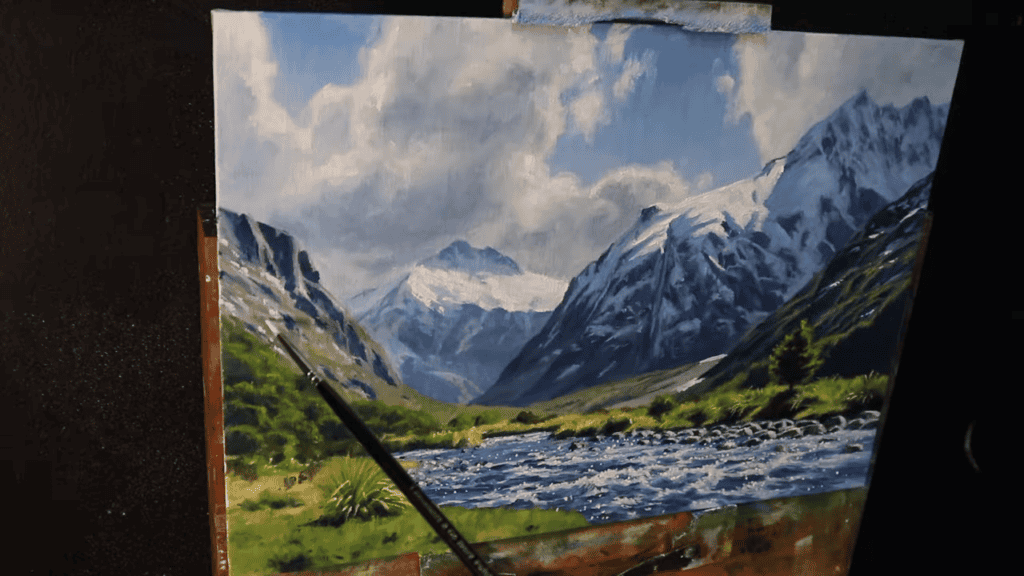
As an artist and blogger, I’ve explored various ways to monetize my blog over the years. I’ve found that the key is to create value for your audience while staying true to your artistic vision. Here’s how I’ve turned my art blog into a sustainable business:
Diverse Revenue Streams for Artists
I’ve discovered that diversifying income sources is crucial for building a stable income from an art blog. Here are the strategies that have worked best for me:
- Selling Painting Tutorial Videos: I create in-depth tutorial videos that teach my landscape painting techniques. These have been a hit with aspiring artists looking to improve their skills.
- Art Coaching and Mentorship Programs: I offer one-on-one coaching and group mentorship programs. This allows me to work closely with artists who want personalized guidance.
- Paid Art School: I’ve developed a comprehensive online art school where students can learn at their own pace. This has been a great way to scale my teaching and reach more artists.
- Free Art Community: I host a free art community on Skool. While this isn’t a direct revenue stream, it’s been invaluable for building relationships and nurturing potential students for my paid offerings.
- Email List: Building my email list has been crucial. It’s not a direct monetization method, but it’s the backbone of my marketing efforts for all my other offerings.
Why I Moved Away from Advertising
In the past, I experimented with Google AdSense on my blog. However, I quickly realized it wasn’t the right fit for my goals:
- Low Returns: The income from ads was minimal compared to my other revenue streams.
- Poor User Experience: Ads cluttered my blog posts and distracted from the content.
- Misaligned Goals: My primary aim is to build relationships with readers and guide them to my courses and mentorship programs. Ads were counterproductive to this goal.
Focusing on Value-Driven Monetization
Instead of relying on ads, I’ve focused on creating high-value offerings that align with my audience’s needs:
- Tutorial Videos: These allow me to share my knowledge while providing immense value to my audience.
- Coaching and Mentorship: By offering personalized guidance, I can help artists overcome specific challenges and accelerate their growth.
- Online Art School: This scalable model allows me to reach more artists while providing comprehensive education.
The Power of Community Building
My free art community on Skool has been a game-changer. While it’s not a direct revenue source, it serves several important purposes:
- Building Trust: It allows artists to experience my teaching style and approach before investing in paid programs.
- Fostering Connections: Artists can connect with each other, creating a supportive environment that enhances the learning experience.
- Content Ideas: The community discussions often inspire new blog posts, videos, and course topics.
Email Marketing: The Backbone of My Strategy
My email list is the cornerstone of my monetization strategy. Here’s why it’s so crucial:
- Direct Communication: It allows me to share new offerings, blog posts, and insights directly with my most engaged audience.
- Nurturing Relationships: Through regular emails, I can provide value, share my artistic journey, and build deeper connections with my audience.
- Targeted Promotions: When I launch new courses or mentorship programs, my email list is the first place I promote them.
Tips for Monetizing Your Art Blog
If you’re looking to monetize your own art blog, here are some tips based on my experience:
- Focus on Value: Create products and services that genuinely help your audience improve their art.
- Build Relationships: Prioritize connecting with your audience over making quick sales.
- Be Authentic: Let your unique artistic voice shine through in all your offerings.
- Start with Your Strengths: Begin with what you’re best at, whether that’s creating tutorials, offering critiques, or teaching specific techniques.
- Evolve Based on Feedback: Listen to your audience and adapt your offerings to meet their needs.
Remember, monetizing an art blog is a journey. It takes time to find the right balance and create offerings that resonate with your audience. Stay true to your artistic vision, focus on providing value, and be patient as you grow your blog into a sustainable business.
Final Thoughts: Embarking on Your Art Blogging Adventure
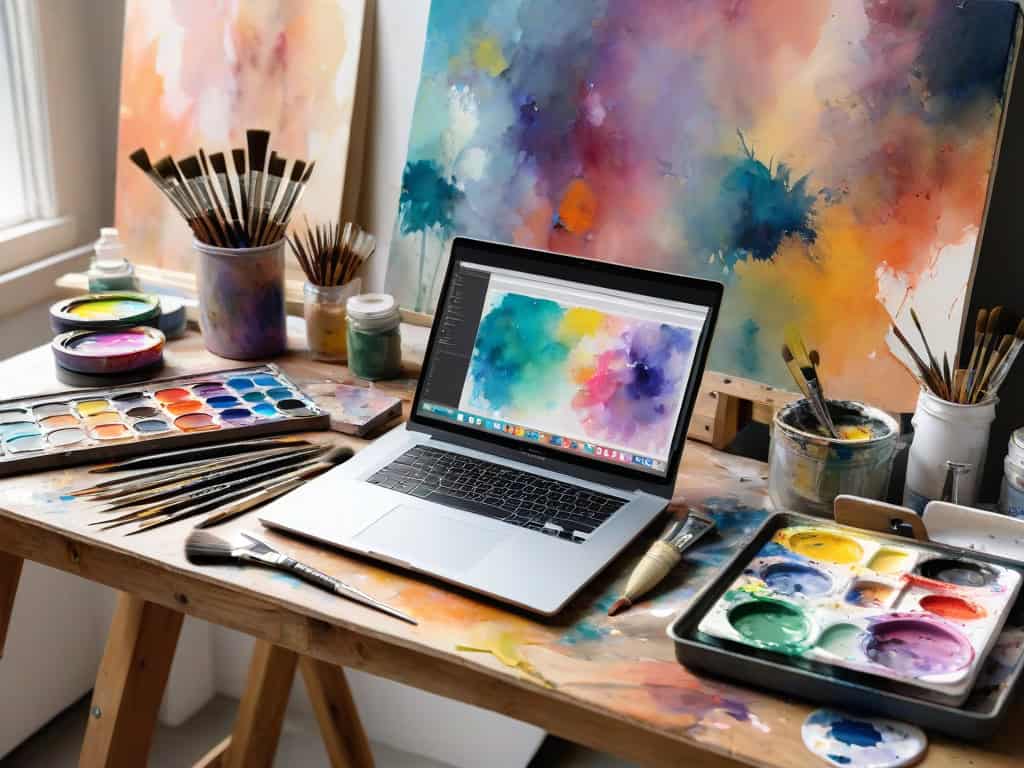
As a landscape artist who’s been on this blogging journey for years, I can tell you that starting an art blog is an exhilarating adventure filled with opportunities for both creative and personal growth. It’s a path that has allowed me to share my passion, connect with fellow artists, and even turn my art into a sustainable business.
The Evolution of an Art Blogger
When I first started, I was sharing painting tutorials. But as I’ve grown, my blog has become so much more:
- A Teaching Platform: Through tutorial videos and blog posts, I’ve been able to share my techniques with aspiring artists worldwide.
- A Community Hub: My blog has become a gathering place for art enthusiasts, fostering discussions and connections.
- A Business Launchpad: It’s been the foundation for my art school, mentorship programs, and other ventures.
The Power of Persistence and Adaptation
Success didn’t come overnight. It took time, dedication, and a willingness to adapt. Here’s what I’ve learned:
- Find Your Unique Voice: Your artistic style is unique, and your blog should reflect that.
- Consistency is Key: Regular posting keeps your audience engaged and helps build your authority.
- Embrace Technology: Tools like KWHero for SEO and MailerLite for email marketing have been game-changers for me.
- Listen to Your Audience: Their feedback has guided my content creation and helped shape my offerings.
Beyond Financial Gains
While monetization is important, the rewards of art blogging extend far beyond finances:
- Artistic Growth: Explaining my process in blog posts has deepened my understanding of my own art.
- Global Connections: I’ve connected with artists and art lovers from around the world.
- Making an Impact: Helping others improve their art is incredibly fulfilling.
Your Art Blogging Journey Awaits
As you stand at the beginning of your art blogging journey, remember that every artist’s path is unique. Your blog is a canvas waiting for your unique brushstrokes. Here’s my advice as you begin:
- Start with Passion: Let your love for art drive your content.
- Be Authentic: Share your genuine artistic journey, including the ups and downs.
- Provide Value: Whether it’s tutorials, inspiration, or insights into your process, always aim to give your readers something valuable.
- Engage with Your Community: Respond to comments, encourage discussions, and build relationships with your readers.
- Stay Open to Learning: The digital landscape is always evolving. Stay curious and be willing to try new things.
There are numerous resources available to help you on this journey. From SEO tools to analytics software, use these to guide your path. But at the end of the day, it’s your dedication to creating meaningful, engaging content about art that will be the key to your blog’s success.
Disclaimer
This blog post may contain affiliate links. This means that I may receive a small commission if you choose to make a purchase through these links. This commission does not affect the price you pay and helps support my art business so I can continue to provide valuable content. I only recommend products and services that I believe in and/or have personally used. Please read my affiliate disclosure for more information. Thank you for supporting my art business!


